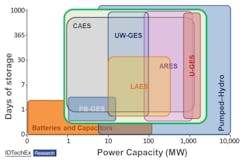Exploring New Energy Storage Options
The electricity market is evolving to allow a higher integration of variable energy sources, and a new class of devices is approaching the market to satisfy this necessity. The was one of the key messages that came out of new research recently released by IDTechEx. The new report, “Potential Stationary Energy Storage Technologies to Monitor,” the emerging class of energy storage devices (characterized by long storage duration and MW size power output) is investigated.
While existing energy storage devices are already populating the market — from Li-ion batteries to pumped-hydro energy storage — this new class of storage technologies will aim to complete the puzzle of the energy storage market. Pushed from the electrification of the automotive sector, Li-ion batteries have been deeply investigated in the last decades and are currently the standard choice for short and medium-duration storage, notes IDTechEx. On the other end of the storage market, it maintains that pumped hydro energy storage (PHES) are the main energy storage systems supporting the grid. These systems have a power capacity of GW scale (1000s of MW), and long storage time, from days upward.
In between these two storage systems, a new group of storage devices is now approaching the market, with an intermediate power range between MW to GW scale and an energy storage capacity that is almost indefinite.
In the report, IDTechEx investigates the following devices:
- Gravitational Energy Storage (GES):
- Piston-Based GES (PB-GES)
- Underground PHES (U-PHES)
- UnderWater GES (UW-GES)
- Advanced Rail Energy Storage (ARES)
- Compressed Air Energy Storage (CAES)
- Liquid Air Energy Storage (LAES)
These devices, which aim to address the front-of-the-meter section of the grid, provide peak-shaving service, grid deferral, and frequency regulation, among other possible services. Moreover, because some of these technologies involved the use of several turbines, some of these devices can address more than one service at the time, therefore increasing the value stacking of these technologies.
For more information on this report, visit www.IDTechEx.com/PotentialSES.

